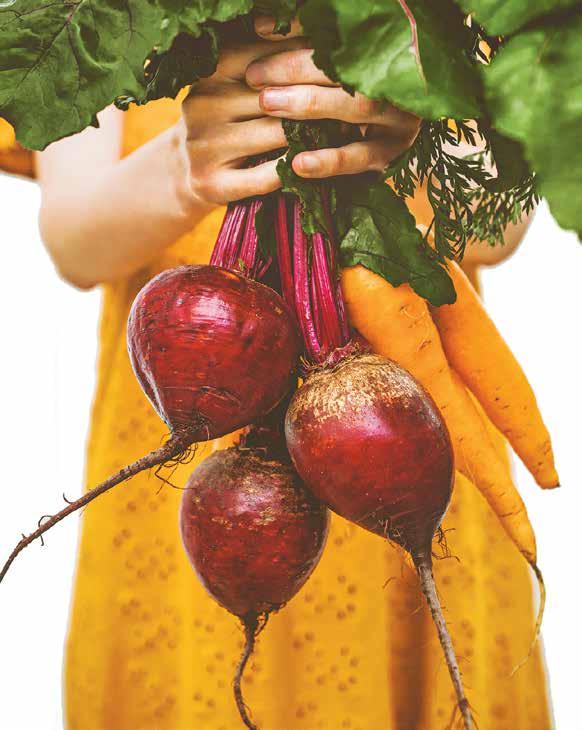
8 minute read
HEALTHY KIDS | 26 CONSCIOUS EATING
Green Schoolyards
CONCRETE JUNGLES BECOME NATURAL PLAYGROUNDS
Advertisement
by Sheila Julson
Skipping rope, playing hopscotch or shooting hoops have traditionally been enjoyed on asphalt-paved schoolyards enclosed by chain-link fencing. But over the last few decades, city leaders, school districts and other stakeholders have been transforming such areas into verdant play-learn spaces, designed for and by students and the community, which also offer green space for surrounding neighborhoods to enjoy during non-school hours. While there is no official definition of a green schoolyard, these projects often share such elements as shade trees and native plantings. Asphalt urban heat islands are being replaced with permeable pavers, rain gardens and vegetative ditches called bioswales to help retain rainwater. Incorporating climate-appropriate materials and arboriculture that provides ornamental shading using trees and shrubs is important, says Alejandra Chiesa, California state director of Green Schoolyards America, a nine-year-old nonprofit. Even poured rubber surfacing or artificial turf can become too hot and contribute to unhealthy environments for children if not shaded, she says. Planting shade trees and selecting cooler materials such as wood, mulch or engineered wood fiber is critical, especially in hotter climates. “Playground equipment made from recycled materials can still get very hot and should be kept under the shade of trees,” she cautions. Green schoolyards can incorporate logs, stumps and play equipment made from real wood which provide great play value and stay cooler. Brenda Kessler, the green schoolyards program coordinator for the Children & Nature Network (C&NN), works with teams made up of city and school district leaders, along with local partners, to implement schoolyard makeovers. The organization is in the process of publishing district design guidelines that detail different features. “We’re not prescriptive, but it can include elements like outdoor classrooms, stormwater retention infrastructure, pollinator gardens, edible gardens, shade structures and boulders,” Kessler says. The Trust for Public Land, which works to create parks and preserve public lands, began transforming schoolyards 25 years ago in response to the shortage of space available for new parks. “Every schoolyard we do across the country looks different. We’re responding to the local requirements,” says Danielle Denk, the Trust’s Community Schoolyards initiative director. The organization has partnered with New York City’s Department of Education for its Schoolyard to Playground Initiative. The program has remade more than 260
schoolyards in all five boroughs, opening up the grounds to extended after-school and weekend hours. Parks that may include such new features as shaded seating and exercise tracks are now within a 10-minute walk for 4 million New Yorkers. In urban areas, large-caliper trees provide shade and bring down the overall temperature of the school, creating a more comfortable indoor learning environment. Trees also improve air quality and noise pollution in schools located in industrial neighborhoods. Dearborn, Michigan, is one such industrial city that seeks to reduce air and noise pollution through green schoolyards. Priya Cook, director of the C&NN green schoolyards program, says its projects support local teams in systems change and initiative. Removing asphalt and replacing it with permeable pavers, bioswales and rain gardens also mitigates flooding. In Milwaukee, C&NN supported scaling work of the Milwaukee Metropolitan Sewerage District to install rainwater retention features on school playgrounds.
Rural communities, which may already have good soil and tree canopies, are also candidates for green schoolyards. “We found in rural communities that the schools serve an important civic role. Some of these areas do not have a physical park or gathering place for social events. Green schoolyards provide [a] venue for the social infrastructure that is crucial in rural America,” Denk says.

OUTDOOR LEARNING SPACES
Green schoolyards can offer hands-on learning spaces where children help with planting, mulching and soil health. Wildlife habitats, native gardens and natural ecosystems offer opportunities to learn about migrating birds and insects. Raised bed vegetable gardens provide nutrition and gardening education. Cook says academic benefits go beyond learning about nature: “One feature that comes up a lot is creating space for outdoor learning in general. Many subjects can be taught outside, whether or not they’re physically focused on that natural environment.” Green schoolyards are going international. C&NN is spearheading a multi-organizational effort to create a Global Lesson on Greening School Grounds and Outdoor Learning project; the plan will be drafted at a meeting this November in Salzburg, Austria. “We’re all coming together to advance green schoolyards worldwide,” Kessler says.
Sheila Julson is a freelance writer and regular contributor to Natural Awakenings. Services and Classes Focused on Balancing Mind, Body and Spirit
Angel Cards, Books, Crystals, Incense, Jewelry & more Jewelry & more
A community of holistic practitioners offering:
Acupuncture, Angel card readings, coaching, BioMat, energy work, hypnosis, intuitive readings, massage, numerology, nutritional counseling, past life exploration, refl exology, Reiki, soul astrology, sound healing & more
Group workshops & events
• Meditation • Psychic & Healing Fair & more
Come in to browse, chat or raise your energy! 45 South Main St., Medford • 609.975.8379
TheCenterLifeInBalance.com
TheCenterLifeInBalance@gmail.com

Fall Beets
VERSATILE LEAF-TO-ROOT EATS
by April Thompson
Versatile, nutritious, colorful and flavorful, beets are quite the package deal. This easy-to-grow, multi-season vegetable is packed with nutrition and plays well with other ingredients. Beets can be enjoyed raw, roasted, boiled or pickled. They can be blended into quick dips, thin-sliced for healthy chips or incorporated into desserts for a mild, sweet flavor and bold color. “Beets have been a staple ingredient on our vegetarian menus for generations. They are an easy way to add natural sweetness and gorgeous color to so many dishes, both savory and sweet,” says Danica Wilcox, owner of the Moosewood Restaurant, in Ithaca, New York, which is celebrating its 50th anniversary next year. The quintessential vegetarian eatery’s go-to beet dishes include hummus, burgers and borscht.
“Beets boast so many health benefits.
Being rich in folate, manganese and copper, they are good for heart, brain and bone health. They are also a good source of fiber, which will feed the good bacteria in your gut, leading to improved gut health,” says Candace Bell, a Phoenix-based holistic nutritionist and food blogger at The Wheatless Kitchen. “Beets have a unique earthy flavor that goes perfectly with bright citrus. Roasting them brings out their sweet and savory flavors, and they pair well with arugula, crunchy walnuts and tangy goat cheese in a salad.” Lisa Keys, of Kennett Square, Pennsylvania, author of the food blog Good

Grief Cook, grows beets and uses them in a number of ways. “Beets get their color from natural plant pigments called betalains, which contain antioxidants and anti-inflammatory properties that help control illnesses like diabetes and heart disease,” she says. Her blog offers a recipe for a hearty, roasted beet sandwich, which pairs the root veggie with feta and a smashed avocado, dill, lime and yogurt spread.
Versatility is one of the beet’s star qualities. The root vegetable can be quick-pickled with other garden vegetables, pureed into soup, roasted for a side dish, shredded raw into salads, juiced into a smoothie or even concentrated into a powder—a favorite of registered dietitian nutritionist Mascha Davis, in Los Angeles. “Beet powder can be added to so many recipes for a fast and easy superfood boost,” she says. Her go-to applications for beet powder include a beet and rose latte, a beet-colored “pink yogurt” topped with berries and cacao nibs, and overnight oats swirled with beet powder.
If the benefits of the beetroot didn’t
already run deep enough, its stems and leaves are not only edible, but also packed with vitamins A, B and K, as well as copper, manganese, iron and calcium. The greens make a great side dish to accompany a beetroot main dish or can be incorporated into a beet soup, salad, sandwich or smoothie for a zero-waste meal turbocharged with nutrients.
Like spinach, chard and other vegetables in the goosefoot family (Chenopodiaceae), beets are rich in oxalates which can contribute to kidney stones. For most healthy people, though, oxalates aren’t harmful, if enjoyed in moderation.
Connect with Washington, D.C., freelance writer April Thompson at AprilWrites.com.

BEET, GREENS AND GOAT CHEESE LINGUINE
2 medium, fresh organic or local beets with leaves ¼ cup unsweetened jasmine green tea (or water), hot or cold 1½ Tbsp extra-virgin olive oil Juice and zest of ½ lemon (1½ Tbsp juice) 2 large garlic cloves ¾ tsp sea salt 10 oz dry, whole-grain linguine 2 oz soft, artisanal goat cheese or soft cashew cheese, crumbled ¼ cup fresh, small basil leaves
Preheat the oven (or toaster oven) to 350° F. Wash, dry and remove the leaves from the beets; thinly slice the leaves and chill until ready to use. Wrap the beets in recycled aluminum foil and roast in the oven until cooked through and tender, about 1 hour and 15 minutes. When cool enough to handle, scrape off the beet skin using the dull side of a paring knife, then chop the beets. In a blender, add the chopped beets, tea, olive oil, lemon juice and zest, garlic and salt. Blend until velvety smooth, at least 2 minutes. Set aside. (Tip: Be careful. This purée will stain anything that it may be splattered onto.) Bring a large saucepan of water to boil over high heat. Add salt to the water, if desired. Add the linguine and cook according to package directions. (Alternatively, try my lid-cooking technique to save energy: After stirring the linguine into the boiling water, cover with a lid and turn off or remove from heat. Let cook without heat per the same timing suggested on the pasta package.)
While the pasta is cooking, pour the beet purée into a large sauté pan and bring just to a boil over high heat. Reduce heat to medium-low, add the beet greens and cook while stirring until the greens are wilted, about 5 minutes.
Drain the pasta, reserving ½ cup of the cooking liquid. Add the pasta to the beet sauce and gently toss with tongs to combine. Add desired amount of reserved cooking liquid (if any) and gently toss to combine. Transfer to a large serving bowl and sprinkle with the goat cheese and basil. Sprinkle with additional lemon zest, if desired, and serve.


